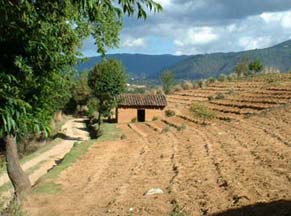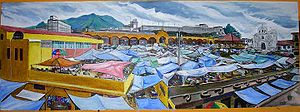
San Francisco El Alto
Encyclopedia

Municipality
A municipality is essentially an urban administrative division having corporate status and usually powers of self-government. It can also be used to mean the governing body of a municipality. A municipality is a general-purpose administrative subdivision, as opposed to a special-purpose district...
in the Totonicapán department
Departments of Guatemala
||Guatemala is divided into 22 departments :#Alta Verapaz#Baja Verapaz#Chimaltenango#Chiquimula#Petén#El Progreso#El Quiché#Escuintla#Guatemala#Huehuetenango#Izabal#Jalapa#Jutiapa#Quetzaltenango#Retalhuleu#Sacatepéquez...
of Guatemala
Guatemala
Guatemala is a country in Central America bordered by Mexico to the north and west, the Pacific Ocean to the southwest, Belize to the northeast, the Caribbean to the east, and Honduras and El Salvador to the southeast...
.
The municipality includes the villages or aldeas of: Chivarreto, Chirrenox, Pabatoc, Paxixil, Rancho de Teja, Pachaj, Sacmixit, San Antonio Sija, Saquicol Chiquito, and Tacajalbé. The Sacmixit community forest is located within the municipality.

History
Before the Spanish Conquest, Chuisiguán was a K'iche' languageK'iche' language
The K’iche’ language is a part of the Mayan language family. It is spoken by many K'iche' people in the central highlands of Guatemala. With close to a million speakers , it is the second-most widely spoken language in the country after Spanish...
Mayan community at the site of San Francisco El Alto. Chuisiguán is K'iche' for "place on the precipice," apt for its location at the top of a steep hill.(account suspended)
Historical chronicler Francisco Antonio de Fuentes y Guzmán mentions the town in his 1689 Recordación Florida. This record confirms the town's pre-Columbian origins. He noted 2,880 Mayan inhabitants and 720 "tributarios."
Residents of San Francisco El Alto joined the revolt against excessive tributes that began on 1820-02-20 in Santa María Chiquimula
Santa María Chiquimula
Santa María Chiquimula is a municipality in the Totonicapán department of Guatemala....
.
Today the local economy thrives on the hundreds of small family-owned and operated clothing fabricators, with the result that clothing exports now exceeds the traditional 'Big Three' of coffee, sugar and bananas. One result of the Civil War was the mass-emigration of Indigenous Maya to the United States and a massive influx of 'remesas' (electronic remittances) to their families, with the result that for several years, over 50% of the country's economy was cash remittances to the Indigenous Maya.
Since people of purer Spanish descent were less likely to emigrate and receive refugee status, the balance of economical and political power has sharply shifted from Spanish domination to increased opportunities for the industrious Maya. This can be seen from the bustling textile market days that literally choke the entire urban area of San Francisco El Alto, making it a favorite tourist destination.
Transportation has also improved as flotillas of tricycle taxis (tuk-tuks) and passenger vans (micros) provide services to any location in the area. While the Maya remain suspicious of anyone from outside small rural communities, they are interested in foreign contacts and often invite travelers into their homes and festivals.
External links


